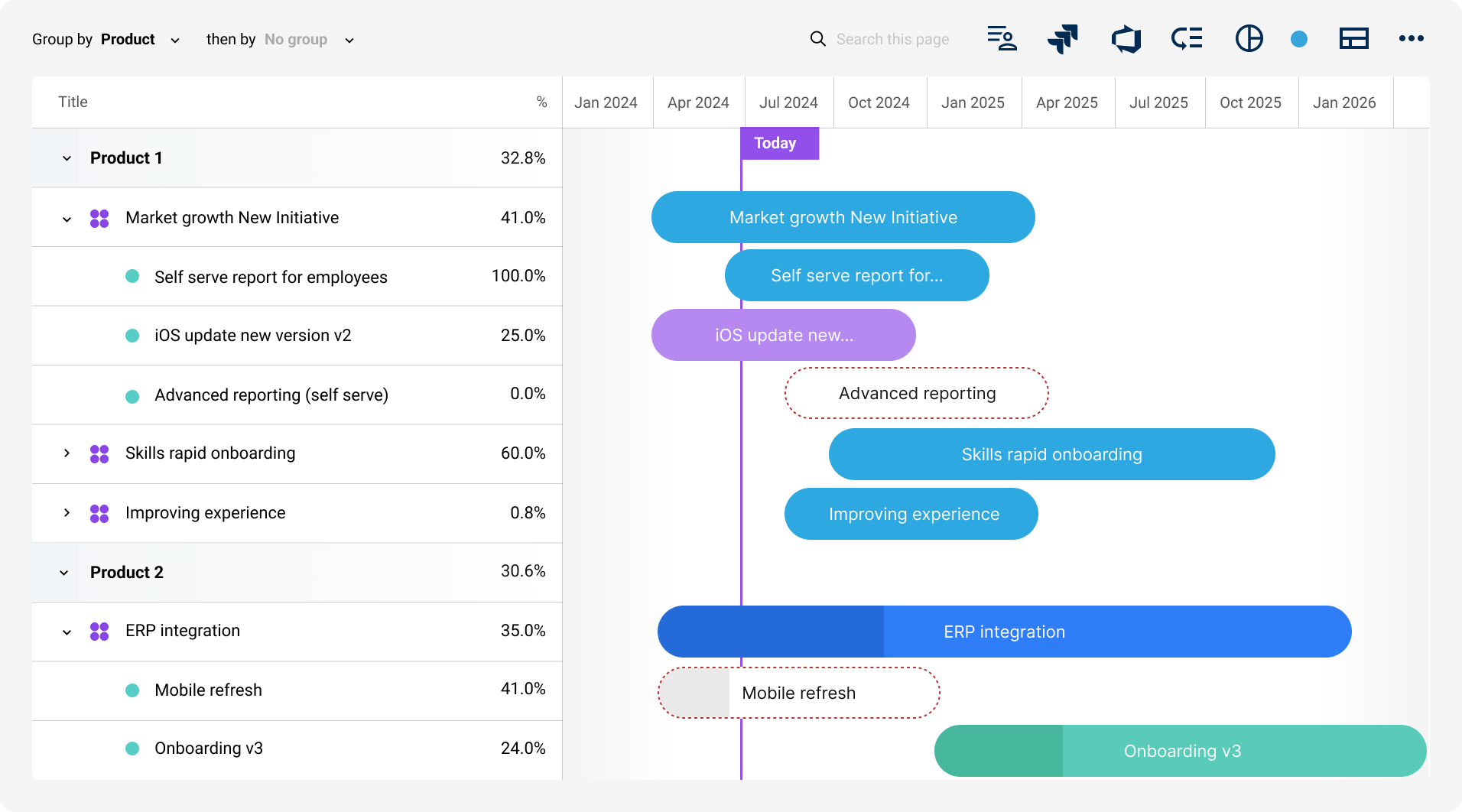Roadmapping Tool: Benefits and Common Challenges
A roadmapping tool is software designed to help teams plan, visualize, and communicate strategic initiatives, projects, and product development timelines. These tools are used by product managers, marketing teams, and executives to ensure alignment, track progress, and manage resources effectively.
Roadmapping is a crucial part of product portfolio management (PPM), providing a structured approach to organizing ideas, prioritizing product features, collecting customer feedback, and aligning product plans with business goals.
Who Uses A Roadmapping Tool?
- Product Teams – To plan development and feature releases.
- Marketing Teams – To coordinate campaigns and content strategy.
- Engineering Teams – To align development with business priorities.
- Executives – To track company-wide initiatives.
Key Features of A Roadmapping Tool
- Timeline Visualization – Gantt charts, Kanban boards, or swimlanes for tracking.
- Prioritization & Planning – Frameworks like RICE, MoSCoW, and Impact vs. Effort for data-driven decision-making.
- Collaboration & Communication – Real-time updates and integrations with communication and engineering tools.
- Goal Alignment – Links initiatives to business goals, KPIs, and OKRs.
- Stakeholder Visibility – Custom views for executives, developers, and marketing teams.
Common Types of Roadmapping Tools Used by Product Teams
Product teams use a variety of tools to manage their roadmaps, each with different levels of effectiveness:
- Homegrown or Make-shift Tools: General-purpose tools like Airtable, Google Sheets, and Notion, that offer flexibility but lack built-in product management functionalities.
- Project and Task Management Tools: Tools like Asana, Monday.com, Jira and Azure DevOps, that focus on execution but often lack strategic roadmapping capabilities.
- Roadmap Visualization Tools: Tools like ProductPlan and Roadmunk, that primarily serve as visual planning aids without deeper integration into product development workflows.
- Product Management Tools: Tools like Productboard and Jira Advanced Roadmap, that include discovery features but may lack outcome-based decision-making frameworks.
- Product Portfolio Management (PPM) Tools: Platforms like Dragonboat that integrate roadmapping with strategic decision-making, resource allocation, and outcome-based execution.

What A Roadmapping Tool Should Help Product Teams Do
- Prioritize & Build the Right Products – Enable dynamic prioritization to ensure high-impact product development that balances customer needs, business goals, and market trends.
- Deliver Products Efficiently – Provide visibility into dependencies, scope changes, and resources bottlenecks before they impact delivery.
- Drive Product Adoption (Go-to-Market Alignment) – Facilitate collaboration between product, sales, marketing, and customer success teams to improve adoption rates.
- Evaluate Performance & Rebalancing Investments – Enable outcome tracking and resource allocation dynamically to support ongoing investment decisions.
Challenges with Traditional Roadmapping Tools
Traditional roadmapping tools often fall short in critical areas necessary for modern, agile product teams:
- Outcome Blindness: Many traditional roadmapping tools focus on features rather than business outcomes, leading to a backlog-driven rather than goal-driven approach.
- Delivery Blindness: Lack of visibility into execution, dependencies, and potential delivery risks.
- GTM Misalignment: Failure to align all key stakeholders, especially go-to-market teams, resulting in ineffective product launches and poor user adoption.
- Process Blindness: Inability to support cross-functional planning, iteration, and execution processes, leading to inefficiencies and misalignment.
- No Investment Rebalancing: Traditional tools focus on delivering features rather than enabling strategic portfolio rebalancing based on changing business priorities.
- Lack of Alignment & Autonomy: Many tools do not provide the flexibility to align high-level strategies with team-level autonomy for execution.
Learn more about the signs you’ve outgrown your roadmapping tool.
Roadmapping Tools vs. Portfolio Management Tools
Roadmapping tools are designed primarily to help visualize plans over time. Their core functionalities typically include:
- Visualization: Create visual roadmaps that clarify the timeline and milestones of a project, making it easier for stakeholders to grasp the strategic plan at a glance.
- Stakeholder Alignment: Facilitate communication and alignment among team members, stakeholders, and executives by providing a clear and concise representation of project timelines and deliverables.
- Flexibility: Offer adaptable formats that can change as project scopes or timelines are adjusted, ensuring that the roadmap remains an accurate reflection of current plans.
Product portfolio management (PPM) tools encompass a wider range of capabilities. These tools go beyond visualization to incorporate:
- Multi-Product Management: Handle multiple products or initiatives simultaneously across teams, allowing managers to see overlaps, manage resources across projects, and prioritize effectively.
- Resource Balancing: Assess and allocate resources, ensuring that plans have the resources to be delivered on time.
- Dependency Management: Track and manage dependencies across different projects, preventing bottlenecks and unforeseen conflicts that can derail timelines and increase costs.
- Strategic Alignment: Link organizational strategy with execution by ensuring that all initiatives align with business goals to facilitate decision-making that supports overall business outcomes.
- Analytics and Reporting: Provide advanced analytics to evaluate the health and progress of the portfolio, offering insights into areas like portfolio performance, resource utilization, and ROI.
Why Upgrade From A Roadmapping Tool to a Product Portfolio Management Tool?
For teams looking to scale beyond roadmapping tools, a Product Portfolio Management (PPM) tool provides a more holistic, outcome-driven approach by:
- Connecting strategy with execution in real-time.
- Enabling dynamic prioritization based on business objectives.
- Facilitating cross-functional collaboration between product, engineering, and go-to-market teams.
- Allowing for investment rebalancing based on performance insights.
Learn more about the differences between a roadmapping tool and product portfolio management tool.
Conclusion
Choosing the right roadmapping tool is crucial for effective product management. As organizations grow, transitioning from a basic roadmapping tool to an advanced strategic portfolio management platform can enhance strategic alignment, improve resource management, and drive better business outcomes.